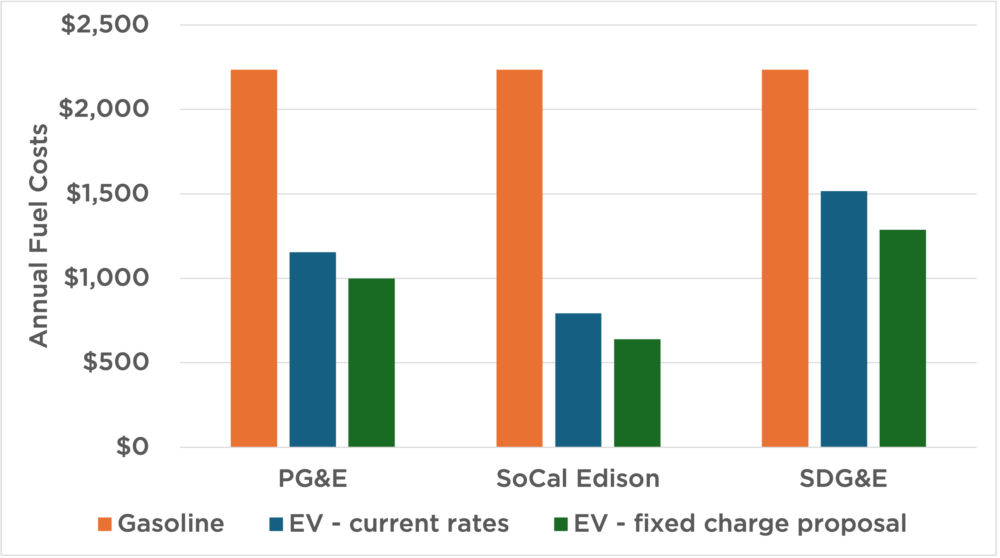Residential electricity rates for many Californians have increased significantly over the last year, making it more expensive to charge an electric vehicle (EV) at home. It’s still cheaper to recharge an EV than buy gasoline, but those savings have been eroded by surging electric rates.
Prompted by a state law, California’s utility regulator has proposed to change the way electricity is billed by adding a fixed monthly charge to all rate plans and making a corresponding reduction to the cost for each unit of electricity used.
Transportation is the largest sector for climate changing emissions, so it’s important that we transition our cars and trucks from gasoline to electricity as quickly as possible. Making sure that EVs are cheaper to recharge will help make that possible.
Fixed charges will reduce the cost of EV charging
Electricity rates for customers of the three large investor-owned utilities in California—Pacific Gas & Electric (PG&E), Southern California Edison (SCE), and San Diego Gas & Electric (SDG&E)—have soared over the last year, with much of the increase tied to the utilities’ wildfire risk management plans (including powerline undergrounding). Unlike most other utilities in the US, the current default rate structure for these three companies doesn’t have a fixed component such as a meter fee or connection charge. This means that an increase in the utilities’ allowed revenue translates directly to higher usage rates (higher costs per kilowatt-hour).
Adding a fixed charge to electricity bills would allow for the reduction of the price per unit of electricity use (cost per kilowatt-hour). The design of this pricing change is meant to keep the total revenue to the utilities constant while reducing the cost of switching from fossil fuels to electricity to power homes and cars.
The proposal from the California Public Utilities Commission (CPUC) would establish a flat fee of $24.15 per month for customers of the state’s big three investor-owned utilities, the same monthly charge that Sacramento Municipal Utility District customers currently pay. The fixed charge would allow the price for electricity usage to be reduced between 4.6 and 6.8 cents per kilowatt-hour for most customers of these utilities when the charge is rolled out between the end of 2025 and early 2026. There are currently optional rate plans from the utilities that include a $15-16 fixed charge with lower rates, but this proposal would bring a fixed charge to all residential customers and reduce the rates on all plans. In addition, low-income households currently on reduced rate plans will be charged a lower fixed charge ($6 or $12) and see the same reduction in electricity rates.
What would a flat monthly electricity fee mean for EV charging?
The CPUC estimates that EV drivers will see about $17 to $25 lower monthly electricity bills under the proposed flat fee. Assuming that EV rate plans see the same rate cuts as the default plans, and assuming that a customer is driving the average efficiency EV for 100 miles, then the cost for someone on PG&E’s EV rate would drop from $11.04 to $9.54. That’s compared to more than $17 to drive a 30-mile per gallon gasoline car for 100 miles of driving when refueling in San Francisco.
Low-income households will pay a lower fixed charge
A potential disadvantage of fixed charges is that households that use very little electricity still have to pay the fixed charge. That unavoidable fixed cost might be a burden for lower-income households.
To remedy this impact, the CPUC’s fixed charge proposal has lower fixed charges for those in the utilities’ current low-income assistance programs. Because those customers will also see the same lower electricity usage rates as everyone else, the total electricity bill should go down for the average customer on a low-income rate plan once fixed charges are adopted. These lower rates would meet the legislative requirement to adopt income-based fixed charges.

Drivers of the average electric vehicle save money on fuel compared to the average gasoline vehicle, but the savings are higher under the proposed fixed cost rates. The average battery electric electric vehicle has an efficiency of 0.294 kilowatt-hours per mile and the average gasoline vehicle is 26 miles per gallon. (Electric rates shown are for the lowest cost Time-of-Use option available.) Source: UCS.
Fixed charges help make climate solutions more attractive, but aren’t a fix for the larger problem.
The recent CPUC rate structure proposal with a modest fixed charge could be an improvement for a lot of Californians.
Fixed charges help reduce the cost of using electricity and therefore make EVs and electric heating more attractive than the more polluting fossil fuel-powered alternatives. But when and if the rate structure change is finalized (planned for late 2025 or 2026), it still won’t get at the reason for a significant portion of the recent electricity rate hikes: wildfire mitigation. The deadly and expensive wildfires increasing electricity bills are tied to climate change, driven in large part by the carbon emissions from large fossil fuel companies.
We’re at a critical moment in California. The transition to clean transportation and clean energy is underway and we have to get it right. The latest fixed charge proposal by the CPUC comes after repeated electricity rate increases that are pinching many California households. The fixed charge proposal is a step in the right direction for preserving the economic benefit of switching from fossil fuels to electricity-based climate solutions since electrifying our homes, cars, and trucks are all critically necessary. But as the costs of climate risks and climate adaptation continue to rise from wildfires, flooding, and heat waves, California will need better policies to ensure that it’s not just ratepayers who are bearing the costs.
How we pay for the cost of powering the state with clean energy must catch up with our climate ambitions. If the state is going to continue to lead on decarbonizing energy and transportation, then California must hold large fossil fuel industry accountable for the costs they have created. We can’t continue to saddle the solutions we need for limiting climate change, like electrification, with the costs created over decades by the fossil fuel industry.

 6 months ago
32
6 months ago
32



